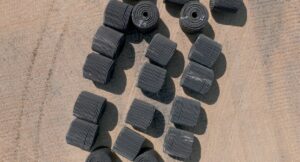Installing drain tile can be an effective way to manage water in agricultural and gardening scenarios, preventing waterlogging and enhancing plant health. However, one critical aspect often overlooked before installation is the importance of understanding your soil type. Soil composition plays a pivotal role in drainage efficiency and the overall success of a drain tile system. In this article, we’ll dive into the significance of knowing your soil types before laying down drain tile and how different soils impact drainage issues.
The Foundation: Why Soil Type Matters
Soil is not just dirt beneath our feet; it’s a living system, complex and varied in its composition. It determines how water moves through the landscape, affecting both natural and artificial drainage systems. Before installing drain tile, a clear understanding of your soil type can help you predict the system’s effectiveness, longevity, and even its design.
Sandy Soil
Characterized by large, coarse particles, sandy soil is known for its high permeability. Water drains through it quickly, making it difficult to retain moisture and nutrients. While this might suggest a lower need for extensive drainage solutions, sandy soils can still benefit from drain tile installations to help manage water distribution more evenly, especially during heavy rains that can lead to rapid surface runoff and erosion.
Clay Soil
On the opposite end of the spectrum, clay soil consists of tiny, compact particles that hold water tightly. Its high water retention capacity can lead to poor drainage, making it prone to waterlogging. In such soils, drain tile systems are crucial. However, they need to be carefully designed with closer spacing and potentially deeper installations to ensure water can be effectively removed from the root zone.
Loamy Soil
Loamy soil, often considered the ideal garden soil, is a balanced mix of sand, silt, and clay. It combines the moisture-retaining abilities of clay with the drainage benefits of sand, providing both water and air for roots. While loamy soils have good natural drainage, adding drain tile can help manage water during unusually heavy rainfall or in areas where the water table is high, ensuring that roots don’t sit in water for prolonged periods.
Silt Soil
Silt soil, with particles smaller than sand but larger than clay, has a smooth texture and retains water well. It can become compacted easily, which may reduce its natural drainage capacity over time. Drain tile systems in silt-dominant areas might need to account for potential compaction, possibly incorporating features to reduce the risk, such as adding organic matter to increase soil structure and porosity.
The Role of Soil Testing
Understanding your soil type is not just about texture but also about structure, pH, organic matter content, and existing drainage patterns. Soil testing is an indispensable step before installing drain tile. It can provide a detailed analysis of your soil’s physical and chemical properties, guiding the design of your drainage system. For instance, knowing the soil pH can inform you about potential amendments needed to optimize plant growth alongside your drainage efforts.
Saline Soil
Saline soil, characterized by high levels of soluble salts, presents unique challenges for drainage systems. Excess salts in the soil can hinder water infiltration and root growth, leading to decreased plant productivity. Drain tile installations in saline soils must address both waterlogging and salinity issues.
Alkaline Soil
Alkaline soils, characterized by a high pH level, present unique considerations for drainage systems. Elevated pH levels can affect nutrient availability, leading to deficiencies in essential elements such as iron, manganese, and zinc. While drainage systems primarily address water movement, they indirectly influence soil pH by regulating moisture levels. In alkaline soils, proper drainage can help mitigate pH challenges by preventing waterlogging, which can exacerbate alkalinity.
Design Considerations for Different Soil Types
Drain Tile Spacing and Depth
The spacing and depth of drain tile lines can vary significantly depending on soil type. Sandy soils might require wider spacing and shallower depths, as water moves quickly through the soil. Conversely, clay soils benefit from closer spacing and potentially deeper installations to efficiently capture and remove water.
Perforated vs. Solid vs. Sock
The choice between perforated and solid pipes depends on your soil type and the intended function of the drain tile. Perforated pipes are suited for areas where water needs to be collected from the surrounding soil, ideal for clay or silt soils. Solid pipes are used to convey water away from an area, such as in sandy soils where the primary concern is redirecting surface water.
In certain soil conditions, the use of sock drain tile—pipes wrapped in a permeable fabric—can offer additional benefits. For example, in sandy soils prone to erosion, the sock helps prevent the infiltration of fine particles into the pipe, reducing the risk of clogging and extending the lifespan of the drainage system. In clay soils, the fabric can act as a filter, preventing soil particles from entering the pipe while still allowing water to pass through. However, in loamy or silt soils where natural filtration is sufficient, sock drain tile may not be necessary and could even impede water flow if not properly installed.
Conclusion
The decision to install drain tile should be informed by a thorough understanding of your soil type and its characteristics. Each soil type presents unique challenges and considerations for the design and implementation of a drainage system. By taking the time to assess your soil properly, you can optimize your drain tile installation, ensuring it works effectively to improve water management on your land. Remember, successful drainage is not just about moving water away; it’s about creating the optimal balance of moisture and aeration for plant health, a goal best achieved with a tailored approach based on the unique properties of your soil.


